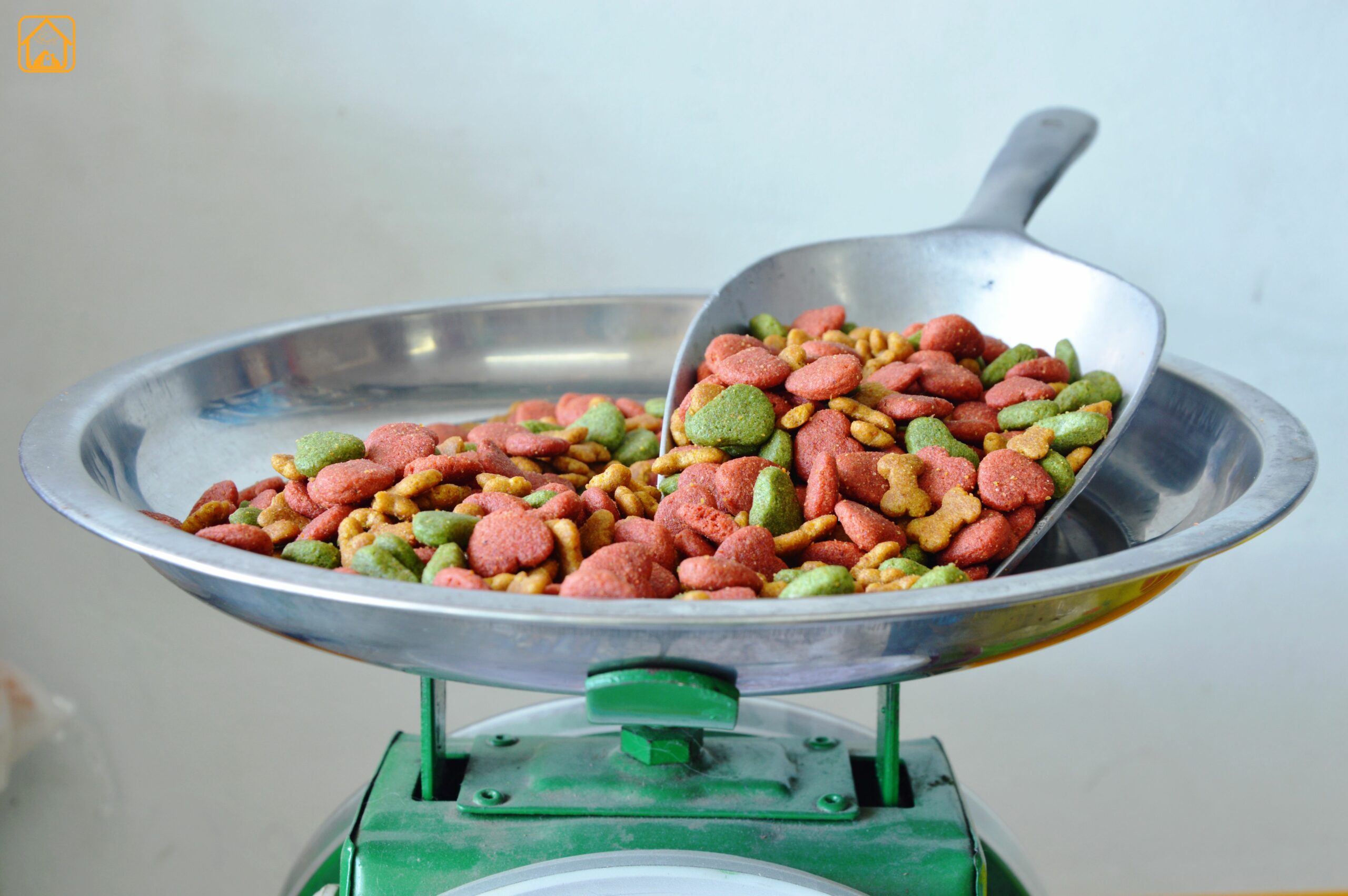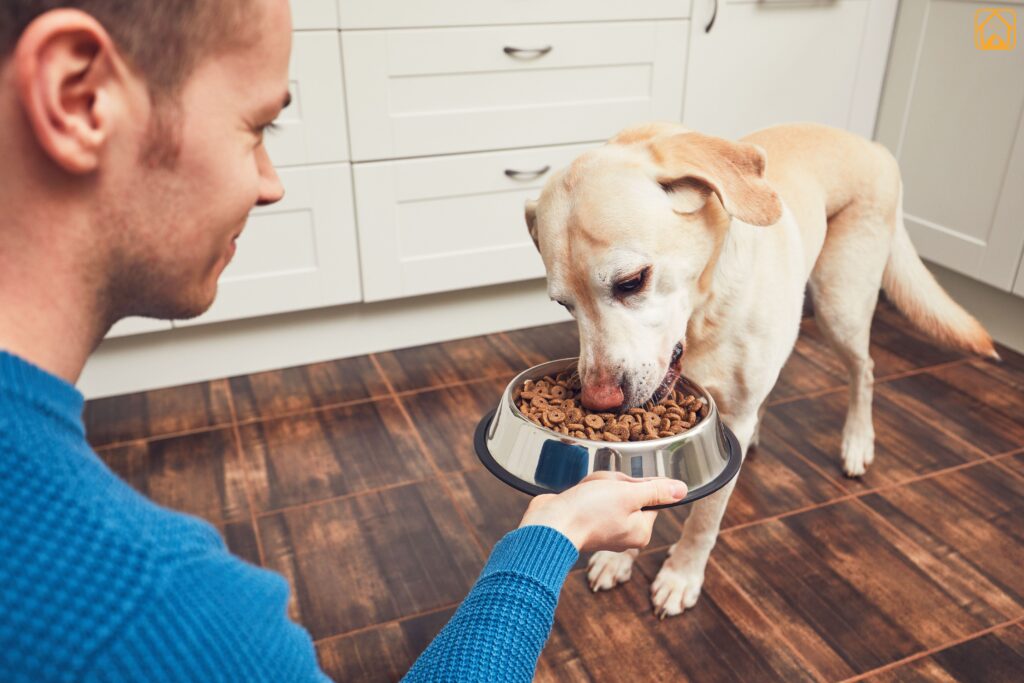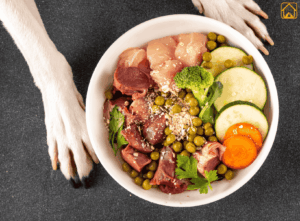With so many options like feeding charts, calculators, schedules, and food types you might feel unsure what to feed. But don’t worry, this guide will break down the essentials of adult dog feeding in a clear, compassionate way, so you can feel confident you’re giving your dog the best.
Understanding Adult Dog Nutrition Needs
Adult dogs need more than just calories, they need high-quality protein, healthy fats, fiber, and a range of vitamins and minerals to keep them thriving. Unlike the wild days as puppies, adult dogs have steadier nutritional requirements. Their meals should support strong muscles, healthy skin and coat, sharp minds, and lasting energy.
It’s important to remember: dogs are omnivores. They benefit from a mix of animal and plant-based nutrients. AAFCO (Association of American Feed Control Officials) sets nutritional standards for complete and balanced dog foods. Look for this label when choosing commercial food.
Why Balanced Nutrition Matters
Here’s the deal, feeding too much can lead an active dog to achy joints and a higher risk of diabetes or heart trouble. But underfeeding isn’t harmless either, it can drain your dog’s energy, dull their coat, and leave them missing key nutrients. According to the Association for Pet Obesity Prevention, almost 60% of dogs are overweight or obese. That’s a staggering number, and it all starts with the scoop in your hand.
I remember switching my own dog from puppy food to adult kibble and worrying, “Will this keep her just as lively?” A balanced adult dog feeding routine helps prevent weight gain, supports joint health, and even helps avoid digestive problems. For perfectly balanced and nutritious meals, read our Dog Nutrition Guide to understand what your dog really needs.
Key Factors Affecting How Much to Feed an Adult Dog
Not every dog eats the same, or should! Several factors impact how much you should feed your adult dog:
- Weight and Body Condition: The ideal amount to feed is based on your dog’s ideal weight, not necessarily their current one. Overweight dogs need fewer calories; underweight dogs need more. A body condition score helps you judge if your dog’s at a healthy size.
- Breed and Size: Small breeds burn calories faster than large breeds, while giant dogs need more food by sheer volume. Some breeds are prone to weight gain, while others have lightning-fast metabolisms.
- Age: Even among adult dogs, younger adults might need a bit more than seniors. Most vets consider dogs “adult” between 1-7 years, depending on breed. (For senior feeding tips, check our senior dog feeding guide.)
- Activity Level: Is your dog more of a nap-all-day type or always on the move? Dogs who get lots of exercise need more calories. Working, sporting, or highly active pups may need up to twice as much food as a laid-back couch companion.
- Reproductive Status: Spayed and neutered dogs usually require fewer calories. Pregnancy and nursing, on the other hand, demand more energy.
- Health Conditions: Dogs with medical issues like diabetes, allergies, or obesity need specialized feeding plans. Always consult your vet for these cases.
- Type of Food: Kibble, canned food, raw diets, or home-cooked meals all have different calorie densities. Always read the label for feeding recommendations, then adjust based on your dog’s needs.
Personal Experience
It’s funny how dogs can be so different. My friend’s Beagle needs small, careful meals or she gains weight fast. But my Border Collie runs so much, he burns off everything he eats. That’s why feeding charts are just a starting point. Every dog needs the right amount based on how active they are.
Adult Dog Feeding Charts
Most dog food brands include an adult dog feeding chart on the package. These charts usually base recommendations on your dog’s weight and sometimes activity level. But here’s the catch, these charts are guidelines, not gospel.
- Find your dog’s weight in kilograms or pounds on the chart.
- Check the recommended daily amount, often shown in cups or grams.
- If you feed twice daily, remember to split the daily total between meals.
Sample Adult Dog Feeding Chart
| Dog Weight (kg) | Estimated Calories | Food in Grams |
| 5 KG | 200 Kcal | 53 gm |
| 10 KG | 400 Kcal | 105 gm |
| 20 KG | 674 Kcal | 177 gm |
| 30 KG | 989 Kcal | 260 gm |
| 40 KG | 1272 Kcal | 335 gm |
| 50 KG | 1540 Kcal | 405 gm |
| 60 KG | 1575 Kcal | 415 gm |
| 70 KG | 1820 Kcal | 480 gm |
| 80 KG | 2070 Kcal | 545 gm |
| 90 KG | 2100 Kcal | 553 gm |
To estimate your dog’s caloric needs, veterinary nutritionists recommend:
- Daily calories ≈ (Dog’s weight in kg x 30) + 70
Example: A 20 kg (44 lb) dog needs about (20 x 30) + 70 = 670 calories daily (plus or minus, depending on activity and other factors).
Always adjust based on your dog’s appearance and energy levels. If you’re unsure, talk with your veterinarian for a more personalized adult dog feeding guide.
How to Use Dog Feeding Calculators and Weight-Based Guides

Online dog feeding guide calculators can help estimate how much food your dog needs per day, based on their weight, age, and activity. Simply input the numbers, and you’ll get a recommended daily intake.
Steps to Use a Calculator
- Weigh your dog accurately. (Tip: Weigh yourself holding your dog, then subtract your own weight!)
- Input your dog’s breed, age, weight, and activity level into a reliable calculator.
- Compare the result to your food’s nutrition panel and feeding chart.
If your dog seems hungry or is gaining weight, tweak the amount up or down. A good adult dog feeding schedule relies on ongoing observation.
Feeding Schedules: How Often and When to Feed Adult Dogs
Most adult dogs thrive on two meals a day, once in the morning, once in the evening. Consistent adult dog feeding times help regulate digestion, prevent accidents, and keep energy steady.
Best Adult Dog Feeding Times
- Morning: Between 7:00-9:00 AM
- Evening: Between 5:00-7:00 PM
Some dogs do fine with once-a-day feeding, but splitting meals can help prevent hunger and reduce the risk of bloat, especially in large breeds. If you’re ever unsure, stick to a twice-a-day routine for the best adult dog feeding results.
Honestly, on busy mornings, I’ve been tempted to skip breakfast, but my dog’s expectant stare says it all, routine matters.
Types of Feeding Methods: Portion Control, Free Feeding, and Hand Feeding
Deciding exactly how much to put in your dog’s bowl can feel like solving a puzzle. One day, your pup seems exciting; the next, they barely touch their food. But the truth is, there’s a science to adult dog feeding, and it starts with portion control. Here’s how you can confidently decode those feeding charts and keep your dog at their healthiest weight.
1. Start with the Label, But Don’t Stop There
Every commercial dog food comes with an adult dog feeding chart or guideline. These charts usually suggest a daily amount based on your dog’s weight. It’s a solid starting point. But here’s the thing, those numbers are just averages! Your dog might need more or less, depending on their metabolism, activity, and body condition.
- Find the recommended daily amount (in cups or grams) for your dog’s weight on the label.
- Divide by the number of meals you feed per day (typically two for adults).
2. Factor in Your Dog’s Unique Needs
- Weigh your dog regularly: Aim for every 2-4 weeks. Use the weight to adjust portions up or down as needed.
- Check for ribs and waist: You should be able to feel (but not see) your dog’s ribs and spot a waist from above. No waist? Time to cut back a bit.
- Consider life stage and activity: Working dogs, agility champs, or dogs that hike with you will need more calories than laid-back lap dogs.
- Spayed or neutered: These dogs often need a little less food than intact dogs.
3. Use a Dog Feeding Guide Calculator
Still feeling unsure? Tech to the rescue! Try a dog feeding guide calculator or a calculator by weight in kg. Enter your dog’s info, and you’ll get a starting estimate tailored to breed, size, and age.
Note: Always check your dog food’s calorie content and consult your vet for precise needs.
4. Adjust as Needed
Here’s where the art part kicks in. Watch your dog’s body, not just the bowl. If your dog’s gaining weight, reduce the portion by 10%. If they’re losing weight or seem hungry, add a little more.
- Track treats: Treats should make up less than 10% of daily calories. Yes, even those puppy eyes have limits.
- Weigh food, not just measure cups. Kibble densities vary between brands and flavors. If you want to be super-precise, use a kitchen scale.
A personal tip, I keep a small notebook where I write down what my dogs eat, their weight, and any changes I notice. It helps me see patterns early like if they’re gaining too much weight or not before it becomes a big problem.
5. When in Doubt, Ask for Help
Your veterinarian is your best ally. They can help interpret your dog’s body condition and recommend portion sizes based on health, activity, and any special needs. Don’t hesitate to bring up questions about adult dog feeding at your next checkup.
Calculating portion sizes is a blend of science, observation, and a dash of intuition. You’ve got this. There’s no one-size-fits-all for adult dog feeding. Here’s a quick look at the main options:
Tips from Experience
I once tried leaving food out all day for my retriever turned out to be a big mistake. He treated it like an endless buffet and gained weight quickly! For most dogs (and families), feeding measured portions at set times works much better to keep them healthy and in shape.
Common Feeding Mistakes and How to Avoid Them
We all want our dogs to feel loved, and sometimes that means a few extra treats or a scoop. But small mistakes can add up over time. Here are the pitfalls I see most often, and how you can dodge them like a pro.
- Guessing on Portions: Guessing how much to feed by just looking can lead to weight gain. Use a measuring cup or a kitchen scale for accuracy.
- Ignoring the Feeding Chart: Feeding charts and adult dog feeding guidelines are there for a reason. Adjust for your pet’s size, age, and activity, but don’t just wing it.
- Too Many Treats: Those little biscuits add up! Remember, treats should be less than 10% of your dog’s daily calories. Try healthy alternatives like carrot sticks or apple slices.
- Feeding Table Scraps: Human food is often high in fat, salt, and sugar. Plus, some foods (like grapes, onions, or chocolate) are toxic to dogs. Save the people’s food for people.
- Sudden Diet Changes: Switching food overnight can upset your dog’s stomach. Transition gradually over a week or so.
- Not Adjusting as Dogs Age: Mature and senior dogs need fewer calories. Update their diet as they slow down.
- Overlooking Water: Dogs need fresh, clean water at all times. Dehydration is sneaky and dangerous.
- Ignoring Signs of Illness: Loss of appetite, vomiting, or diarrhea are red flags. Don’t wait, call your vet.
And here’s a big one: Never punish or scold a dog for not eating. Appetite changes can be caused by stress, illness, or even just a hot day. Be patient, experiment with food temperature or texture, and check with your vet if problems persist.
Choosing the Best Food and Feeding Bowls for Adult Dogs
The best adult dog feeding routine starts with quality food and safe bowls. Look for dog foods labeled as “complete and balanced” for adults, with real meat as the first ingredient and no excessive fillers.
- Stainless steel or ceramic bowls are easy to clean and resist bacteria.
- Slow-feeder bowls help fast eaters pace themselves.
Got a dog that eats too fast or steals food? Try a puzzle feeder or a slow-feed bowl. It makes mealtime last longer and keeps your dog busy and happy.
FAQs: Adult Dog Feeding
How much should I feed my adult dog per day?
Most adult dogs need about 2-4% of their body weight in food daily, but this varies based on breed, activity, and food type. Always check your food package’s adult dog feeding chart and adjust as needed.
Can I use a dog feeding guide calculator?
Yes! Feeding calculators (often found on dog food websites) estimate daily portions based on your dog’s weight, breed, and activity. They’re a great starting point but watch your dog’s body condition to fine-tune amounts.
Is it okay to feed my dog once a day?
Some adult dogs do fine with once-a-day feeding, especially with high-quality, calorie-dense food. However, many experts recommend splitting meals to support digestion and reduce hunger. If you have a large breed, twice-a-day feeding is safer.
What’s the best time to feed a dog twice a day?
Early morning (7-9 AM) and early evening (5-7 PM) are ideal. Consistent timing helps with digestion and routines, something most dogs actually love.
How do I know if my dog is overweight or underweight?
Check for a defined waist and ribs you can feel but not see. If you’re unsure, your vet can do a body condition assessment. Sudden changes in appetite, energy, or weight are always worth a check-in.
What are the risks of free feeding?
Free feeding can lead to overeating, weight gain, and food guarding, especially in multi-dog homes. It can work for self-regulating dogs, but portion control is usually safer.
What if my dog is always hungry?
Some dogs love to eat, regardless of need! If they’re healthy, maintaining weight, and your vet agrees, try slow-feeder bowls and low-calorie treats to help them feel full.
Should I change my dog’s food as they age?
Yes, dogs’ nutritional needs shift with age. Switch to a senior formula around age 7 (sooner for big breeds), or as advised by your vet. Senior foods often have fewer calories and added joint support.
Conclusion
Feeding your adult dog isn’t a science test, it’s a daily chance to keep them healthy, energetic, and, honestly, just plain happy. Trust your instincts, measure portions, and don’t be afraid to ask your vet for help. Here’s to many more satisfied tail wags at mealtime!



